Accretion onto a charged black hole in consistent 4D Einstein-Gauss-Bonnet gravity
IF 10.5
4区 物理与天体物理
Q1 ASTRONOMY & ASTROPHYSICS
引用次数: 0
Abstract
In astrophysics, accretion is the process by which a massive object acquires matter. The infall leads to the extraction of gravitational energy. Accretion onto dark compact objects such as black holes, neutron stars, and white dwarfs is a crucial process in astrophysics as it turns gravitational energy into radiation. The accretion process is an effective technique to investigate the properties of other theories of gravity by examining the behavior of their solutions with compact objects. In this paper, we investigate the behavior of test particles around a charged four-dimensional Einstein–Gauss–Bonnet (4D EGB) black hole in order to understand their innermost stable circular orbit (ISCO) and energy flux, differential luminosity, and temperature of the accretion disk. Then, we examine particle oscillations around a central object via applying restoring forces to treat perturbations. Next, we explore the accretion of perfect fluid onto a charged 4D EGB black hole. We develop analytical formulas for four-velocity and proper energy density of the accreting fluid. The EGB parameter and the charge affect properties of the test particles by decreasing their ISCO radius and also decreasing their energy flux. Increasing the EGB parameter and the charge, near the central source reduces both the energy density and the radial component of the infalling fluid's four-velocity.
在一致的四维爱因斯坦-高斯-邦纳引力下,带电黑洞的吸积
在天体物理学中,吸积是一个大质量物体获得物质的过程。下落导致引力能的提取。黑洞、中子星和白矮星等黑暗致密物体的吸积是天体物理学中一个至关重要的过程,因为它将引力能转化为辐射。吸积过程是一种有效的技术,可以通过研究其他引力理论的解与致密物体的行为来研究它们的性质。本文研究了带电四维爱因斯坦-高斯-博内(4D EGB)黑洞周围测试粒子的行为,以了解它们最内层的稳定圆轨道(ISCO)以及吸积盘的能量通量、光度差和温度。然后,我们通过应用恢复力来处理扰动来检查围绕中心物体的粒子振荡。接下来,我们将探索完美流体对带电4D EGB黑洞的吸积。建立了吸积流体的四速和适当能量密度的解析公式。EGB参数和电荷通过减小粒子的ISCO半径和降低粒子的能量通量来影响粒子的性能。增大中心源附近的EGB参数和装药量会降低流入流体四速度的能量密度和径向分量。
本文章由计算机程序翻译,如有差异,请以英文原文为准。
求助全文
约1分钟内获得全文
求助全文
来源期刊

Journal of High Energy Astrophysics
Earth and Planetary Sciences-Space and Planetary Science
CiteScore
9.70
自引率
5.30%
发文量
38
审稿时长
65 days
期刊介绍:
The journal welcomes manuscripts on theoretical models, simulations, and observations of highly energetic astrophysical objects both in our Galaxy and beyond. Among those, black holes at all scales, neutron stars, pulsars and their nebula, binaries, novae and supernovae, their remnants, active galaxies, and clusters are just a few examples. The journal will consider research across the whole electromagnetic spectrum, as well as research using various messengers, such as gravitational waves or neutrinos. Effects of high-energy phenomena on cosmology and star-formation, results from dedicated surveys expanding the knowledge of extreme environments, and astrophysical implications of dark matter are also welcomed topics.
 求助内容:
求助内容: 应助结果提醒方式:
应助结果提醒方式:


